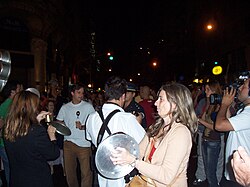Cacerolazo
In Venezuela , Chile , Argentina and Catalonia, the term cacerolazo is used to describe a loud form of protest , which is mainly used by the middle class. This form of demonstration also received international attention during the last great economic crisis in Argentina . The name comes from Cacerola (Spanish for pot ), as a key feature of these demonstrations is the generation of noise on pots and pans brought by the demonstrators. This should often also express that “the pots are empty”, i. that is, there is nothing left to eat. The form of protest can be traced back to the displeasure of Chilean middle-class women during Allende's reign, when they protested against the food shortage and corresponding rationing under his socialist government.
But also against the subsequent dictatorship of Pinochet in Chile in the 80s, this form of mass protests was later expressed, which was also used in the massive student protests in 2011.
Although this form of protest is mostly carried out on the streets, it is not absolutely necessary to go out on the streets. It is therefore particularly suitable for mobilizing people to protest who would never take part in a traditional demonstration. Especially in the final phase of the Argentine President Fernando de la Rúa after the freezing of all bank balances, there were several cacerolazos and so-called apagones (conscious, massive switching off of all domestic light sources at a certain night time), in which large parts of the middle class took part.
The largest and most famous cacerolazo took place on December 19 and 20, 2001 in the Plaza de Mayo of Buenos Aires and led to the resignation of the then President Fernando de la Rúa. This was the climax of the economic crisis, followed by an epoch of instability in which five people were supposed to hold the presidency of Argentina within just 13 days: Fernando de la Rúa , Ramón Puerta , Adolfo Rodríguez Saá , Eduardo Camaño and Eduardo Duhalde .
The cacerolazo is an integral part of anti-government protests in Argentina. In the course of 2002 the term was adopted in Venezuela , where the middle class also demonstrated with pots against the policies of President Hugo Chávez .
Protests of this kind have also been taking place in Catalonia since summer 2017 as part of the region's striving for independence. This is particularly true in the context of the referendum of October 1, 2017 , with supporters of a split expressing their displeasure with the behavior and decisions of the Spanish government and the Spanish king express.
Individual evidence
- ↑ Forms of protest and their origin. Retrieved August 25, 2011 .
- ↑ Hundreds of arrests during educational protests in Chile. In: amerika21. August 5, 2011, accessed August 5, 2011 .
- ↑ Minuto a minuto: "Cacerolazos" en varias zonas de Santiago (minute by minute: "Cacerolazos" in many districts of Santiago "). In: El Mercurio Online (Emol). August 5, 2011, accessed on August 5, 2011 .
- ↑ Spanish court orders imprisonment for key separatist leaders. Spiegel Online, October 16, 2017, accessed on the same day.

